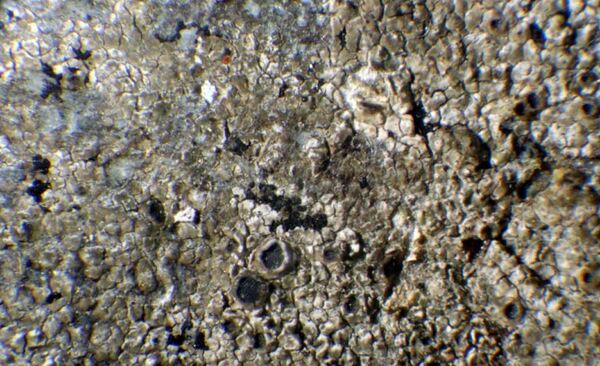Aspicilia subdepressa Arnold
Verh. zool.-bot Ges. Wien, 19: 611, 1869.
Synonyms: Lecanora subdepressa (Arnold) Nyl.; Pachyospora subdepressa (Arnold) M. Choisy
Distribution: N - TAA (Nascimbene & al. 2022), Piem (Morisi & Sereno 1995), Lig (Roux & al. 2011).
Description: Thallus crustose, episubstratic, rimose- to verrucose-areolate, 0.1-0.3 mm thick, brown or green-brown, rarely grey-white pruinose, forming 1.5-6 cm wide patches, sometimes delimited by a discontinuous, dark prothallus. Areoles 0.2-1(-2) mm wide, angular or partly rounded, slightly to strongly convex; sometimes producing marginal, wart-like isidioid outgrowths in sterile specimens; marginal areoles more or less slightly elongated. Cortex with a brown upper layer overlain by a thin epinecral layer, the lower part colourless, without crystals; medulla white, I-, rich in crystals insoluble in K and in N. Apothecia lecanorine-aspicilioid, 0.2-0.8 mm across, round, scarce to abundant, with a concave, black, epruinose disc, and a thick, prominent thalline margin. Epithecium grey-green, 8-15 μm thick, N+ emerald green, usually without crystals; hymenium colourless, 100-120 μm high, I+ blue turning reddish brown; paraphyses sparingly branched, anastomosing and submoniliform in upper part, 1.5-2.5 μm thick at base, the terminal cells to 5 μm wide; hypothecium colourless, 30-40 μm high, I+ blue, filled with crystals. Asci 8-spored, clavate, the thin outer coat K/I+ blue, the wall and apical dome K/I-, with 1-2-seriately arranged spores. Ascospores 1-celled, hyaline, ellipsoid, 18-27 x 10-17 μm, thin-walled. Pycnidia pyriform, the wall colourless except around the ostiole. Conidia short-filiform, straight to slightly curved, 7-12 μm long. Photobiont chlorococcoid. Spot tests: cortex and medulla K+ yellow, C-, KC-, P+ orange. Chemistry: stictic acid complex, incl. norstictic acid in low amounts. Note: a silicicolous species of vertical to inclined rocks in rather dry areas, with optimum in the montane belt. For a detailed description see Roux & al. (2011).
Growth form: Crustose
Substrata: rocks
Photobiont: green algae other than Trentepohlia
Reproductive strategy: mainly sexual
Poorly known taxon in need of further study
Commonnes-rarity: (info)
Alpine belt: absent
Subalpine belt: extremely rare
Oromediterranean belt: absent
Montane belt: rare
Submediterranean belt: extremely rare
Padanian area: absent
Humid submediterranean belt: absent
Humid mediterranean belt: absent
Dry mediterranean belt: absent

Predictive model
Growth form: Crustose
Substrata: rocks
Photobiont: green algae other than Trentepohlia
Reproductive strategy: mainly sexual
Poorly known taxon in need of further study
Commonnes-rarity: (info)
Alpine belt: absent
Subalpine belt: extremely rare
Oromediterranean belt: absent
Montane belt: rare
Submediterranean belt: extremely rare
Padanian area: absent
Humid submediterranean belt: absent
Humid mediterranean belt: absent
Dry mediterranean belt: absent

Predictive model
 INDEX FUNGORUM
INDEX FUNGORUM
 GBIF
GBIF
 DOLICHENS
DOLICHENS



